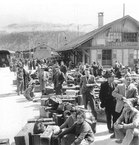
Unternavigation
The postwar economic boom would not have been possible without the mass immigration of foreign workers. In 1950, 285,000 foreign nationals were present in Switzerland was at; twenty years later this number had soared to 1,080,000 (an increase from 6.1 to 17.2 percent of the population). A large portion of immigrants initially came from Italy, followed by other countries in southern Europe, such as Spain, Portugal and Yugoslavia. Residence permits were usually issued for a limited duration, meaning that the majority of foreign workers had to leave Switzerland for a while after less than one year - a mechanism that became known as the rotation principle. Permanent residence and the admission of family dependents became easier only from the 1960s onwards. However, immigration policy tightened against the backdrop of increasingly xenophobic sentiment, as manifested in the Schwarzenbach popular initiative against ‘foreign infiltration’ (Überfremdung). In response, the Confederation took measures to stabilize the proportion of foreign residents, for instance by prescribing quotas and contingents for individual companies and countries of origin.
Social insurance was also affected by the recruitment of foreign workers. In 1929, Switzerland had acceded to a convention of the International Labour Organization (ILO), which sought to prevent discrimination in accident insurance. Foreign workers began paying into the AHV from the very beginning, without necessarily being able to claim benefits later. Switzerland also entered into bilateral social insurance agreements with a number of countries governing the provision of benefits abroad in particular. For instance, the 1949, 1951 and 1962 agreements with Italy facilitated the transfer of old age survivor’s insurance (AHV) and disability insurance (IV) to Italy and prescribed mandatory health insurance for Italian workers. However, discrimination persisted and affected many seasonal and short-term residents. This was especially the case with voluntary insurance schemes. Seasonal workers were thus afforded no protection against unemployment and had limited access to occupational old age provision.
Literatur / Bibliographie / Bibliografia / References: Arlettaz Gérald, Arlettaz Silvia (2006), L’Etat social national et le problème de l’intégration des étrangers 1890 – 1925, Studien und Quellen, 31, 191–217; Gees Thomas (2006), Die Schweiz im Europäisierungsprozess. Wirtschafts- und gesellschaftspolitische Konzepte am Beispiel der Arbeitsmigrations-, Agrar- und Wissenschaftspolitik, Zürich; Mahnig Hans (ed.), Histoire de la politique de migration, d’asile et d’integration en Suisse depuis 1948, Zürich.
(12/2014)




